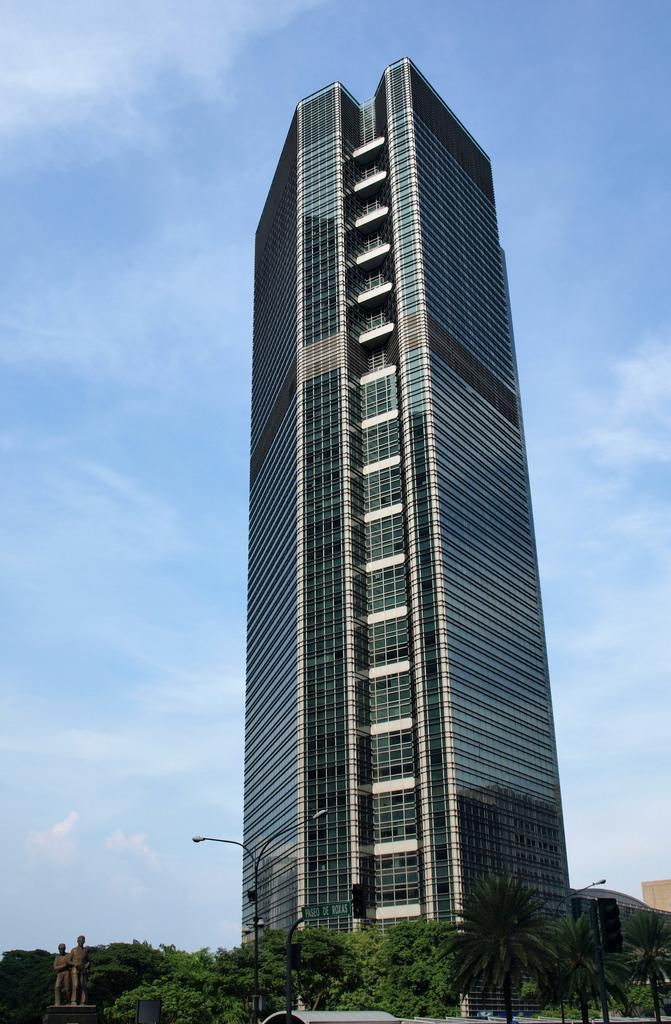
The Philippine Stock Exchange or Pamilihang Sapi ng Pilipinas is the national stock exchange of the Philippines. It is one of the oldest stock exchanges in Southeast Asia, having been in continuous operation since its inception in 1927. It currently maintains two trading floors, one at its headquarters in the Philippine Stock Exchange Centre (formerly Tektite Towers), Ortigas Center in Pasig City, and one at the Ayala Tower One in Makati City's Central Business District. The PSE is composed of a 15-man Board of Directors, chaired by José T. Pardo.
The main index for PSE is the PSE Composite Index or PSEi, which is composed of thirty listed companies. The selection of companies in the PSEi is based on a specific set of criteria. There are also six additional sector-based indices.
Trading on the PSE trading starts at 9:30 am PST and ends at 12:00 pm, pauses for a 1 hour 30 minute break, and resumes trading from 1:30 pm to a 3:30 pm session closure.
History
The Philippine Stock Exchange was formed from the country’s two former stock exchanges, the Manila Stock Exchange (MSE), established on August 8, 1927, and the Makati Stock Exchange (MkSE), which was established on May 27, 1963.
Although both the MSE and the MkSE traded the same stocks of the same companies, the bourses were separate stock exchanges for nearly 30 years until December 23, 1992, when both exchanges were unified to become the present-day Philippine Stock Exchange.
In June 1998, the Securities and Exchange Commission (SEC) granted the PSE a "Self-Regulatory Organization" (SRO) status, which meant that the bourse can implement its own rules and establish penalties on erring trading participants (TPs) and listed companies.
In 2001, one year after the enactment of the Securities Regulation Code, the PSE was transformed from a non-profit, non-stock, member-governed organization into a shareholder-based, revenue-earning corporation headed by a president and a board of directors. The PSE eventually listed its own shares on the exchange (traded under the ticker symbol PSE) by way of introduction on December 15, 2003.

Philippine Stock Exchange
Business
On January 4, 1993, the former Manila Stock Exchange started the computerization of its operations using the Stratus Trading System (STS) with a company called Equicom. On June 15, the former Makati Stock Exchange adopted the MakTrade trading system. Both systems were linked on March 25, 1994 to produce a One Price-One Market exchange. Two years later, on November 13, 1995, the implementation of the Unified Trading System (UTS) allowed the use of a single-order-book system on MakTrade software where all the orders are posted and matched in one computer.
In October 2004, the Securities Clearing Corporation of the Philippines (SCCP), a clearing and settlement agency for depository eligible trades, became a wholly owned subsidiary of the PSE. The SCCP acts as the settlement coordinator and risk manager for broker transactions as well as administrator of the trade guaranty fund.
In 2005, the PSE adopted an online daily disclosure system (ODiSy) to improve the transparency of listed companies and ensure full, fair, timely and accurate disclosure of material information from all listed companies. The ODiSy provides a 24/7 online system access for the submission of all types of disclosures.
On July 26, 2010, the PSE launched its new trading system, PSEtrade, which replaced the MakTrade system. The system was acquired from the New York Stock Exchange.
On March 3, 2012, the PSE Composite hits 5,000 mark the highest record close.
Indices and components
The PSE has eight constituent indices:
- PSE All Shares Index (ALL)
- PSE Composite Index (PSEi)
- PSE Financials Index (FIN)
- PSE Holding Firms Index (HDG)
- PSE Industrial Index (IND)
- PSE Mining and Oil Index (M-O)
- PSE Property Index (PRO)
- PSE Services Index (SVC)
The PSEi is the main index of the PSE, while the All Shares Index is the broader index of the exchange. The remaining six indices are sector indices based on a company's main source of revenue. Although listed in an index, companies are listed on the PSE under the First Board, Second Board or the Small and Medium Enterprises Board based on market capitalization.
As of May 22, 2012, the Philippine Stock Exchange has 344 listed companies with a total market capitalization of US$229 billion. There are also 134 trading participants registered at the PSE.
Getting around
The Epifanio De los Santos Avenue (EDSA) pass along the southeast part of Makati and connects the city with Mandaluyong City and Pasay City. The South Luzon Expressway (SLEX) runs through the western part of Makati and connects the city with Manila to the north and with southern Metro Manila. The Skyway, an elevated highway built on top of SLEX, provides residents coming from southern Metro Manila a fast way to reach Makati.
Buses plying the Epifanio de los Santos Avenue (EDSA/C-4) route from Baclaran in Parañaque to Quezon City and Caloocan City pass through the central business/financial district daily. Jeepneys ply Makati's inner roads and connect the city to its surrounding towns and cities. The Metro Rail Transit (MRT-3) on EDSA has four stations located in Makati: Guadalupe, Buendia, Ayala and Magallanes. The Philippine National Railways meanwhile has three stations: Buendia, Pasay Road and EDSA.










